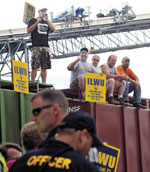
Showdown on West Coast Docks: The Battle of Longview
(November 2011).
click on photo for article
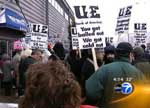
Chicago Plant Occupation Electrifies Labor
(December 2008).
click on photo for article

May Day Strike Against the War Shuts Down
U.S. West Coast Ports
(May 2008)
click on photo for article

March 2018
Teachers Revolts Across the
U.S.
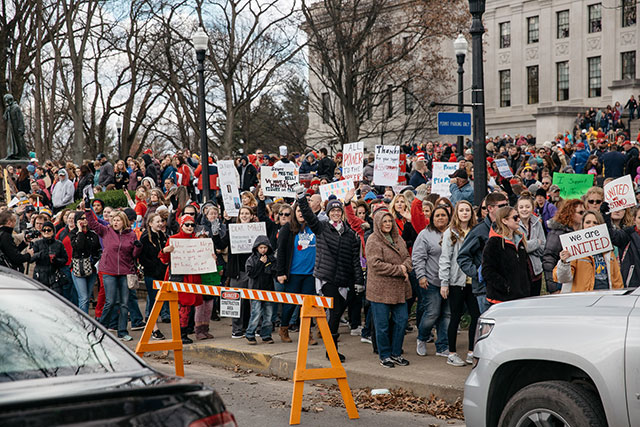
Thousands of teachers, students and supporters marched around West Virginia state Capitol March 2 in student-organized rally backing strike for better pay and benefits for public workers. (Photo: Scott Heins/Bloomberg)
Needed: A Class-Struggle Leadership
Beginning in mid-February, a series of statewide teachers strikes broke out, first in West Virginia, then in Oklahoma and Kentucky, and as we go to press teachers in Arizona have struck as well. They are all states where teachers unions have historically been weak and where salaries and school funding have been at the bottom of the scale nationwide. After years of cutbacks and falling pay, with many if not most teachers having to take second (and third) jobs just to survive, the rebelling education workers (including staff and bus drivers) had had enough and walked out.
In each case, the strikes were sparked by rank-and-file teachers holding school-wide meetings and using social media, while the leaders of the state affiliates of the National Education Association and the American Federation of Teachers had to scramble to keep up. And when NEA and AFT tops in West Virginia and Oklahoma settled for token gains, the strikers voted to continue the walkout.
The strikes won important but limited gains, in itself a rare event in recent decades of union defeats. But they lacked a leadership capable of waging hard class struggle and an organizational framework to counter the sellout labor bureaucracy. The Internationalist Group has called for the formation of elected school-based strike committees, including members of all education unions as well as non-union workers, to select delegates (recallable at any time) to statewide coordinating bodies.
We print here the on-the spot-report and analysis of the West Virginia strike.
CHARLESTON/NEW YORK, March 11 – During almost two weeks, the statewide strike by some 30,000 teachers and other school personnel in West Virginia riveted the attention of labor and left activists across the country. For nine school days, every public school (757 in total) in all of the Appalachian Mountain state’s 55 counties was shut down. Thousands of educators flooded the capitol building in Charleston day after day, demanding action from the governor and legislators. Then things really took off when on February 28 strikers refused to go back to work despite the announcement by the governor and union leaders of a deal to raise salaries by 5%, and the 98-1 vote for it by the state House of Delegates.
From the outset in late January, the struggle of the West Virginia education workers – not only teachers but also custodial, cafeteria and bus workers – was driven by unrest in the ranks, who were fed up with seeing their livelihoods ravaged. The leaders of the unions (West Virginian Education Association, American Federation of Teachers/West Virginia and West Virginia School Service Personnel Association) tried to hold the movement in check, and when that failed, to channel it in a “safe” direction with a backroom deal for a 5% raise. But as thousands of union members gathered in the capitol realized their power, and that this business-as-usual policy was leading to a defeat, they rose up against the sellout. Every county voted a resounding, overwhelming “NO!”
The strikers rejected the “agreement” negotiated behind their backs, first of all, because it did nothing to fix the ever-mounting premiums, deductibles and co-pays of the Public Employees Insurance Agency (PEIA) beyond a temporary freeze announced before the strike; and second, because the state Senate was refusing to approve a the pay hike. This became the lightning rod as Republican Senate president Mitch Carmichael deliberately provoked strikers with talk of only a 4% raise, or using the money for the PEIA, or paying for a raise with cuts to social benefits. But as the strikers stood firm, on March 6 the WV Senate approved and the governor signed the bill for the 5% raise, while some other anti-union bills (notably attacking seniority) were shelved.1
The settlement was only a partial victory – partial because nothing was done about the PEIA beyond the 17-month freeze of current levels of costs and benefits (to expire in the summer when there are no schools in session to be shut down by a strike) and a task force appointed by the governor to “study” the problem (a non-solution which even the Charleston Gazette-Mail ridiculed). “A freeze is not a fix,” as teachers’ signs declared and demonstrators chanted over and over in the capitol. Partial also because the paltry raise – barely $2,000 (before taxes) – won’t move the state out of the bottom tier of teacher pay nationally, much less provide a living wage. West Virginia teachers’ pay is reported as averaging $45,000 a year, making it 48th in the U.S., so low that a huge percentage of educators have to take a second job.2
But despite its limited nature, the result was a victory
nonetheless, as an energized, mobilized and united
workforce was able to beat down opposition from hard-nosed
union-busters, and to overcome the foot-dragging,
diversions and outright sabotage by the sellout union
bureaucracy. They did it despite the fact that since 2016,
West Virginia has a so-called “right-to-work” law intended
to cripple unions. Moreover, they did it in the heart of
“Trump country,” where Democrat Hillary Clinton got barely
a quarter of the West Virginia vote in 2016 (the second
lowest state vote in the U.S.) and particularly in the
southern counties where only one in seven voted
Democratic. But these were also the centers of mine worker
militancy, from the mine wars of 1912-22 to the wildcat
strikes of the 1960s and ’70s and the Pittston coal strike
of 1989-90.
Importantly, this was a strike by women unionists – three-quarters of WV and U.S. teachers are female – who were not going to let themselves be pushed around. Certainly not by a governor who called them “dumb bunnies” (at a February 6 town hall event in Logan County) for daring to strike, and not by some labor fakers whose go-along-to-get-along policies have been an unmitigated disaster. In this country where women still only earn 80% as much as men, and in the state of West Virginia where at the present rate women won’t reach wage parity until around 2099 (!), there were plenty of coal miners’ daughters active in the struggle who are ready to, and know how to, fight for their rights – which they did.
What working people from coast to coast witnessed, and
what the West Virginia educators set off, was a stunning
explosion of labor struggle in a union movement paralyzed
for decades by the class collaboration of the
pro-capitalist bureaucracy, forever beholden to the
Democratic Party. The WV teachers strike was not, as some
bourgeois commentators and fake-leftists have claimed, a
revolt against the unions, it was a rebellion inside
the labor movement against the misleaders whose
policies have led to the devastation of the unions. In the
course of the struggle, the labor rebels got a taste
of their power. But, then, so did the capitalist
ruling class, from Wall Street to Main Street. So as
everyone recognizes, the fight is by no means over.
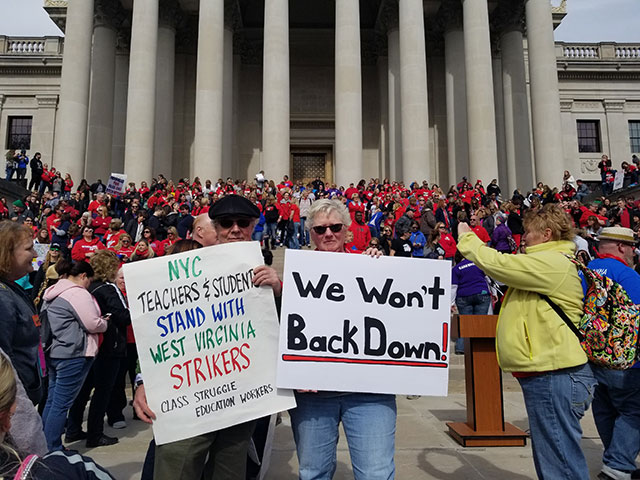
Class Struggle Education Workers brought message of solidarity to West Virginia strikers from City University of New York Conference to Defend Immigrants, March 5. (Internationalist photo)
Across the country, all eyes were on West Virginia. On March 4, an Internationalist team from Class Struggle Education Workers and Revolutionary Internationalist Youth3 drove to Charleston to convey a message of solidarity with West Virginia strikers that had been voted the day before at a City University of New York Conference to Defend Immigrants. At the capitol on March 5, jammed by some 7,000 strikers and supporters, when asked what was going on, an official of the WVEA said he didn’t know, confirming that the union tops were not in control. He said a woman from Mingo County told him, “You can support us but we’re doing it.” More bluntly, other strikers had remarked, “You can either get behind us or we’ll run you over.”
The teachers struck together with school staff and bus drivers, thwarting any attempt at strikebreaking: no buses, no kids. In a state with high poverty rates, where in many schools 100% of students depend on free breakfast and lunch, strikers and other volunteers collected and packed food for their kids throughout the strike. (Senator Carmichael cynically responded, “if you have money to buy food for students, you must not need a raise”!) They communicated through a by-invitation Facebook group, “West Virginia Public Employees United,” that ballooned to 24,000 members. They didn’t flinch when the state attorney general declared the strike “unlawful.” They didn’t buckle when the union tops sold them out for empty promises.
The rank-and-file action was hardly spontaneous. A mid-January protest on Martin Luther King Day reportedly drew a little over a hundred demonstrators to the state capitol. But by the end of the month county-level union assemblies were voting to walk out. A public opinion survey showed 72% thought teacher pay was too low. The strike was also unusual in that it was backed by school superintendants, worried about teachers leaving because of impossibly low pay and benefits (currently the state is short over 700 teachers). This official acquiescence won’t be repeated in a hard labor battle – which is what it will take to win a solid victory.4
The West Virginia strikers went about as far as they could as a loosely organized rebellion. In future battles, forging a leadership with a program for powerful class struggle will be key. It’s necessary to oust the pro-capitalist bureaucrats who have run the unions into the ground, but a generic “rank-and-file opposition” will founder on the shoals of the capitalist state. Look at Miners for Democracy in the 1970s: helped into office by the government and courts, the MfD’s Arnold Miller was soon negotiating sellout contracts just like his predecessor Tony Boyle – and facing wildcat strikes in protest. A real struggle for “affordable health care” and raising teacher pay means taking on the energy conglomerates and the state power that serves their interests.
The teachers’ struggle is political and can’t be won without breaking from all capitalist parties and politicians, whether Trump or the Democrats. As the strikers were leaving the capitol on March 6, Democratic legislators were telling them to “remember in November.” But it was Democratic then-governor, now senator Joe Manchin who first pushed for slashing the state corporate income tax. And the WVEA, AFT/WV and UMWA all endorsed Governor Jim Justice in the 2016 Democratic primary.5 The answer is not some phony labor party like the “Working Families Party,” which is just another ballot line for liberal Democrats.6 What’s needed is a class-struggle workers party fighting to put an end to the dictatorship of capital.
A Strike That Came from the Ranks
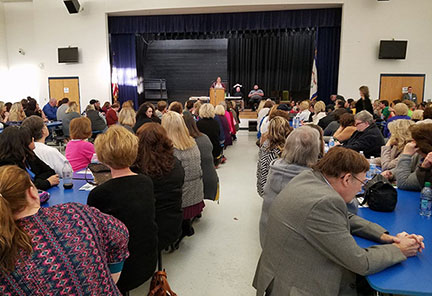 West Virginia teachers strike
originated in county-level union meetings. Right: 240
attended joint WVEA-AFT/WV emergency meeting at Logan
Middle School, January 25. The next day they voted to walk
out. (Photo: WVOW
News/The Logan Banner)
West Virginia teachers strike
originated in county-level union meetings. Right: 240
attended joint WVEA-AFT/WV emergency meeting at Logan
Middle School, January 25. The next day they voted to walk
out. (Photo: WVOW
News/The Logan Banner)The momentum for the statewide strike kicked off on January 25 with a jammed meeting called by the Logan County WVEA together with the AFT and school service personnel. The next day an overwhelming majority voted for a one-day walkout to protest lack of funding for the PEIA, attacks on seniority and the call by the governor for an insulting 1% pay hike. School employees in Mingo and Wyoming counties also voted for a one-day work stoppage and rally in Charleston. The Mingo WVEA president said that state union leaders “kind of suggested that we hold off on it to see what happens, but our people were so fired up about it they said, ‘No we’re not waiting, we’re going to do this now,’ so we did” (Charleston Gazette-Mail, 30 January).
On February 2, hundreds of teachers from the southern counties flooded the state capitol building. A teacher from Logan County commented, “We’re here because we are the coalfields. We’ve been taught since we were little not to put up with this kind of treatment, and we won’t anymore.” In other counties, teachers rallied outside schools in the frigid temperatures before work. On February 11, union representatives from all 55 counties met near Flatwoods, reporting that an overwhelming majority of public school employees had voted for statewide action. After a rally at the capitol on February 16, state union leaders announced a two-day walkout the next week. “The entire state of West Virginia will be shut down,” said WVEA president Dale Lee.
Trying to head off the strike, the state legislature passed a bill raising the pay hike to 2% and the governor ordered a freeze on PEIA payments. But the walkout took place on February 22-23 as upwards of 5,000 strikers filled the capitol with a sea of red shirts, many with red bandannas, symbolizing miners’ struggle. In the face of the strikers’ determination, state union leaders had to extend the walkout to Monday, February 26, and then to Tuesday. By then, Governor Justice and legislators were getting desperate, so in behind-the-scenes talks with union leaders they agreed to a 5% raise. After announcing it, the governor abruptly left (supposedly to coach a girls basketball game). But when WVEA president Dale Lee and AFT/WV leader Christine Campbell spoke on the steps of the capitol, the crowd erupted.
According to various accounts, the thousands of educators gathered there responded angrily, chanting “We won’t back down!” “We aren’t going back for that!” and “Back to the table!” People were angry that they hadn’t been consulted, were presented with a done deal and told to go back to school Thursday. Most media announced that the strike was over. But instead the Wednesday “cooling off period” heated up. In the capitol strikers chanted, “We were sold out!” Again, jam-packed meetings and votes were held, county by county. As reports came in, hour by hour, in each case strikers voted to stay out. By late evening of Wednesday, February 28 every county superintendent in the state had announced that there would be no school the next day.
The biggest issue cited by many for rejecting the deal was the lack of a fix for the PEIA health insurance. But on Thursday the Senate voted to table the bill for the 5% raise, and on Friday it didn’t even put it on the agenda. By then there was talk on the Facebook page of occupying the capitol. However, that went nowhere as there was no organization or means to carry it out. The union leaders told anyone who asked that the movement was out of their hands now. When Carmichael announced his 4% “solution” on Saturday (March 3), they saw their chance, and a joint WVEA-AFT/WV-WSSPA statement called for everyone to come to the capitol Monday to demand that the 5% deal be honored. There was no mention of the PEIA.
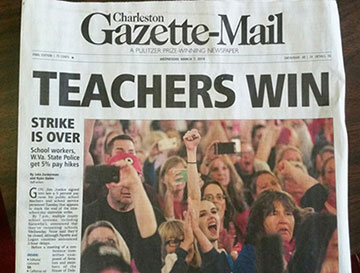 (Dissent
magazine)
(Dissent
magazine)In the end, the agreement that was approved on March 6 was not very different from the deal that teachers rejected six days earlier. The Charleston Gazette-Mail emblazoned on its front page, “TEACHERS WIN.” It’s true that the strikers beat down the hard-line union-busters and made some gains – as we said, a partial victory – due to their determination and unity. But this also reflected the fact that sections of the bourgeois ruling class backed the strike, not only school authorities but particularly pro-Democratic media like the Gazette-Mail. The New York Times (3 March) waxed lyrical about the heritage of coal miners’ struggles and how “West Virginia Teachers Give a Lesson in Union Power.”
The striking educators saw the power of their collective action, and that is a considerable achievement, especially after so many strikes that have been lost by the deadbeat, play-by-the-rules business union bureaucracy. This is already having an effect beyond the state. Worried about a spillover as the Pittsburgh Federation of Teachers scheduled a strike for March 2, the school board there hurriedly negotiated a contract after stonewalling for months. And teachers in Oklahoma, which is No. 49 in teacher pay, have been directly inspired by the West Virginia teachers revolt, planning a walkout on April 2 to demand a $10,000 pay increase. As strikers left the WV capitol on March 6, they chanted “West Virginia first, Oklahoma next!”
Lessons of the West Virginia Teachers Strike
During our visit to Charleston, strikers and their supporters emphasized, “We got the world watching us.” “We’re making history,” teachers kept repeating. “I am part of a history lesson,” said a Kanahwa County eighth-grade history teacher. In fact, as they congregated, thousands strong, day after day in the rotunda and corridors and outside the capitol building, across the country educators, labor and left activists were watching intently, as were capitalist politicians and the bourgeois media. Many are saying that the historic 2018 West Virginia teachers strike could spark the rebirth of a near-moribund labor movement. But for that to happen, one must ask, what are the key lessons to be drawn from this powerful struggle?
The big business press is worried. “Could Wildcat Teachers’ Strikes Spread to Other States?” asked Bloomberg Politics (6 March). Earlier (2 March) it wrote of the walkout as “one of the country’s biggest unauthorized ‘wildcat’ strikes in decades…. As uncommon as work stoppages have become in the U.S., big wildcat strikes like West Virginia’s are almost unheard of.” The liberal New York Times (9 March) headlined about a “crowd-sourced strike” and how “Striking Teachers Defied West Virginia, and Their Own Union, Too.” The Times commented: “Wildcat strikes led by rank-and-file workers are rare these days, but they recall the big miners’ strikes that racked West Virginia’s coal country in the early part of the 20th century. “
The same theme – that the strike was in defiance of or against the unions – is echoed by some leftists. “Wildcat Roars in West Virginia: Teachers to Stay Out on Strike,” declared the anarchist website Its Going Down (1 March). The World Socialist Web Site (6 March) ran an article on “The West Virginia teachers strike and the rebellion against the trade unions.” The WSWS, a/k/a the Socialist Equality Party, claims the unions are “not working-class organizations, but agencies of the corporations and the state” (“Lessons of the West Virginia teachers strike,” 8 March). With pseudo-leftist verbiage, this dubious outfit led by one David North (who for years was CEO of a non-union printing company) aids the bosses by fueling reactionary anti-union sentiment.
The WSWS/SEP poses as Trotskyist even as it rejects Leon Trotsky’s analysis of the unions as workers organizations led by a privileged pro-capitalist bureaucracy, the “labor lieutenants of the capitalist class,” as American socialist Daniel De Leon put it. These imposters write off the unions as bourgeois institutions in order to justify not defending them against capitalist attack.7 Genuine Trotskyists, in contrast, call to defend the unions by ousting the sellout misleaders and forging a class-struggle leadership. As Trotsky wrote:
“The primary slogan for this struggle is: complete and unconditional independence of the trade unions in relation to the capitalist state. This means a struggle to turn the trade unions into the organs of the broad exploited masses and not the organs of a labor aristocracy.”8
– Leon Trotsky, “Trade Unions in the Epoch of Imperialist Decay” (1940)
Unsurprisingly, the WSWS anti-union
propaganda fell flat with the union teachers engaged in a
hard-fought, militant strike.
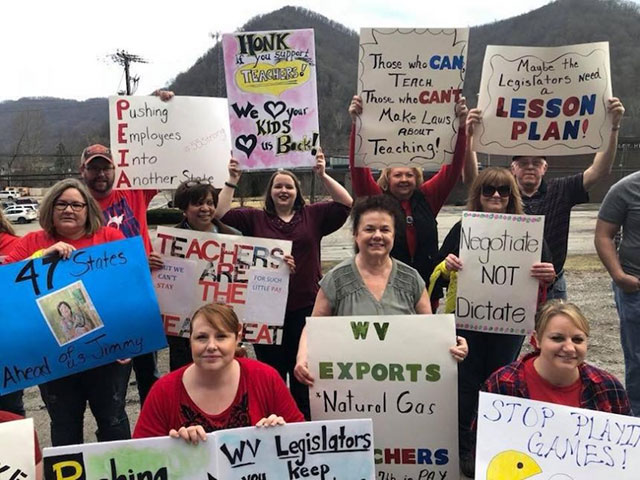
The strike began with two-day statewide walkout, February 22 and 23. Once begun, unon leaders couldn’t stop it. (Photo: AFT/WV Facebook)
Lesson One: The strike was not a wildcat but a revolt inside the unions for a militant policy.
Whether coming from corporate rightists or fake leftists, what these arguments all have in common is that they equate the unions with the union leadership. The West Virginia teachers strike was not a wildcat – it was in fact authorized by all three education unions, both at the state level and in formal votes at the county level. That continued to be so after the strikers said “no” to the February 27 deal, and the union tops still managed to focus the strike on winning the 5%, which hadn’t been the main demand. What is true is that the strike came from the ranks and it partly escaped from the stifling grasp of the labor bureaucracy that is terrified of class struggle (which it is incapable of waging), as that would upset its cozy class collaboration.
Militant strikers were instinctively aware of this, particularly as they nixed the deal with the governor. Rather than denouncing unions, they chanted, “We are the union bosses!” (Jacobin, 1 March). The militants then organized the opposition through the unions at the county level, and the state leaders acquiesced. While labor bureaucrats typically seek to maintain tight control over a strike, or any union action, this was made difficult by the fact that WV public sector unions are prohibited from collective bargaining. In the past, the authorities have tried to play the WVEA and AFT/WV off against each other. But here in order to organize a walkout or strike, all the unions had to get together at the county level, along with non-unionized employees. That was the backbone of the strike, but it was largely informal. The next time there should be an elected mass strike committee based on assemblies of all strikers.
Wildcat? Anyone who had any experience with a real wildcat strike could see the difference. In the West Virginia coalfield wildcats of the mid-1970s, strikers burned effigies of UMWA leader Arnold Miller. Mark Lance of the CSEW, who covered the great 1977-78 coal strike for Workers Vanguard, then the voice of revolutionary Trotskyism, noted that workers shouted down and drove off union reps while burning the contract. (See the Workers Vanguard pamphlet, The Great Coal Strike of 1978.) Here, however, when union leaders spoke – even national AFT and NEA leaders – they were often well-received. Understanding that this was a rebellion against the union leadership, not against the unions, is key to realizing the potential for the West Virginia teachers strike to lead to a revival of class-struggle unionism.
Lesson Two: The West Virginia teachers strike is the answer to Janus.
The strike comes just as the U.S. Supreme Court is considering the case, Janus v. American Federation of State, Municipal, and County Employees, which conservatives are pushing in order to break the power of public employee unions, the last bastion of a once-strong U.S. labor movement. If, as is likely, the Court rules against the union, it would eliminate the “agency shop” whereby unions receive fees from non-members who enjoy the benefits of union-negotiated wages, benefits and job protections. The response of the labor bureaucracy to this existential threat has been to intensify calls to vote Democratic. Class-struggle unionists, in contrast, call to mobilize labor’s power to bust the union-busters.9
The union tops are quite explicit about their role in clamping down on union struggle in order to maintain “labor peace,” at least when talking to the bourgeoisie. An amicus curiae (friend of the court) brief submitted by the AFT in the Janus case argues that eliminating the agency shop would “impair the collaborative relationship,” and lead to a “more confrontational, less cooperative relationship” between the union and management. During the strike, AFT president Randi Weingarten said that backers of Janus should “look at West Virginia for what will happen if they get their way.…. In West Virginia, which lacks collective bargaining, … thousands of teachers mobilized and took on the governor and legislature” (Washington Post, 5 March).
For labor fakers like Weingarten, the West Virginia teachers strike is not an example to be followed but a specter to be waved about in order to scare the bourgeoisie into keeping class collaboration safe and sound; class-struggle unionists, in contrast, see the teachers strike as a harbinger of what a combative labor movement could achieve.
Lesson Three: The strike showed it is possible to break through strike bans.
Asked by the media early on whether a strike would be illegal, WVEA president Lee responded, “probably, yes.” He added that, after explaining the legal consequences to educators, “This is an action that they overwhelmingly voted for us to call, and we called it.” Shortly before it began, state attorney general Patrick Morrisey declared that “the impending work stoppage is unlawful,” and that he was “prepared to act.” This was based on a state supreme court decision dating back to the last West Virginia teachers strike in 1990, when a Democratic attorney general asked to court to declare that “any strike or concerted work stoppage by the public teachers of this state is illegal.” The court agreed, ruling that “Public employees have no right to strike.”
Striking teachers were well aware of the court ruling and the attorney general’s threat, but they weren’t intimidated. Teachers in the capitol had signs noting that unions were once illegal. A math teacher from Calhoun county commented to us, “What Rosa Parks did was illegal; what the suffragettes did was illegal.” Under New York’s Taylor Law and in 23 other states, strikes by teachers and other public employees are expressly illegal, subject to jail sentences and/or fines. The labor bureaucracy hides behind this legal prohibition. The NYC United Federation of Teachers has used this excuse on several occasions to rule out of order proposals for union action by a delegate who is a member of Class Struggle Education Workers. The CSEW calls to shred the Taylor Law with massive strike action.
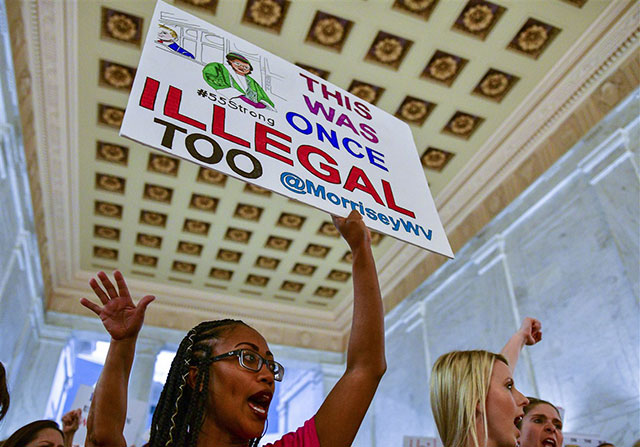
Kanawha County teacher makes a point: Rosa Parks’ refusal to sit in the back of the bus was illegal, and key to civil rights struggle. (Photo: Tyler Evert/AP )
West Virginia teachers just showed that this can be done. Since the state was not prepared to jail 30,000 strikers, especially in the face of broad public support for the teachers, the attorney general’s declaration and the supreme court ruling became dead letters.
Lesson 4: The strike underscored the need to break from all capitalist parties and politicians and to build a workers party that fights for all the oppressed.
The West Virginia teachers strike exploded the myth spread by the Democratic Party that white workers who voted for Trump in 2016 were nothing but anti-union racists. In fact, Obama got far more votes in West Virginia than Hillary Clinton, and West Virginians have far more trust in organized labor (43% in a recent opinion poll) than the rest of the country (28%). The fact is that the Democratic Party’s economic policies and economic desperation due to the devastating loss of coal mining jobs pushed workers into the arms of Trump. Clinton became persona non grata in WV for her statement that “we’re going to put a lot of coal miners out of business.” As for Trump, 49% no longer believe he is bringing back coal jobs, as promised in his presidential campaign (Register-Herald [Beckley], 21 January).
Now we have Governor Jim Justice elected as a Democrat with union backing promising to raise teachers’ pay, then once in office proposing a 1% raise that amounted to a pay cut, while slashing benefits and upping the cost of health insurance. Justice is the owner or CEO of over 50 mining companies, worth $1.6 billion according to Forbes, making him the richest man in the state. Meanwhile, the leading Republican contender for U.S. senator is Don Blankenship, former chairman and CEO of Massey Energy, who was found guilty of conspiracy to willfully violate mine safety and health standards leading to the death of 29 miners in the 2010 Upper Big Branch mine disaster. For this he got a slap-on-the-wrist one-year sentence in a country club prison.
Both Democrats and Republicans represent big business, no matter what they may say on the campaign trail. During the strike, Democratic state senator Richard Ojeda was lionized by the liberal media and many teachers for supporting a pay increase. Yet Ojeda, who supported Bernie Sanders in the 2016 primaries and is now running for U.S. Congress, was elected proclaiming his support for Trump. He boasts of his military record of participating in the brutal U.S. occupation of Afghanistan and Iraq, and while now claiming to support DACA and a “path to citizenship,” he hailed Trump’s call to “take benefits away from people who come here illegally.” This typical double-talking capitalist politician is no friend of labor or the oppressed. Class-struggle unionists call to defeat U.S. imperialism’s wars, for full citizenship rights for all immigrants and for workers action to stop deportations.
In many ways, the West Virginia teachers revolt recalls the 2011 outpouring of labor protest in Wisconsin against the union-busting bill of Republican governor Scott Walker. That, too, was sparked by teachers. It was even bigger – 30,000 workers ringed and occupied the state capitol daily, over 100,000 rallied on weekends – and it lasted longer, almost a month. It brought the state to the brink of a general strike.10 This scared the hell out of even the “progressive” labor leaders, who capitulated as the union tops called off the marches. Instead they told protesters to look to the courts and a recall election – i.e., to vote for Democrats. The recall fizzled, the courts did nothing, the anti-labor law passed, state workers lost the right to collective bargaining, teachers’ wages fell, education unions lost over half their members, and teachers fled the state (12% of high school teachers left in the last year alone). Those are the wages of betrayal.
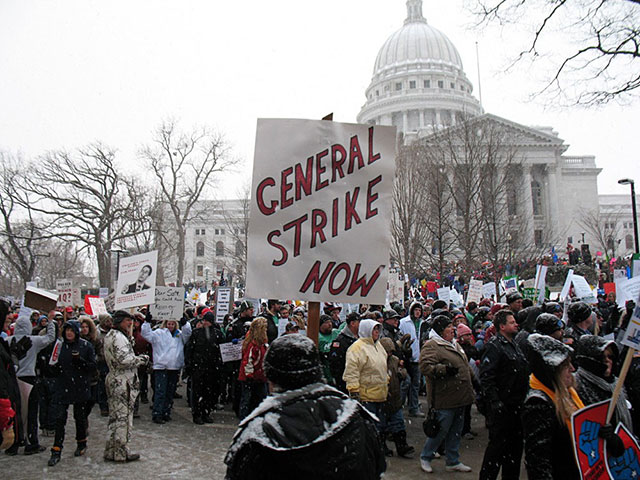
Labor bureaucracy’s betrayal of Wisconsin workers’ struggle on eve of a possible general strike led to devastation of the unions. (Photo: Yuri Keegstra )
The union misleaders’ chaining of the workers movement to the partner parties of U.S. capitalism and imperialism is central to their sabotage of workers’ class interests. Democrats governed West Virginia on behalf of the coal bosses for generations, from the 1930s until 2014, presiding over endless mine disasters and closures, and slashing taxes on the energy giants.11 The Democratic nomination of billionaire mine boss Justice is nothing new: West Virginia Democrats elected Jay Rockefeller, first as governor and then as senator, from 1977 to 2015. Class-conscious labor militants in West Virginia should instead follow the example of the Portland, Oregon Painters Local 10 that in 2016 declared:
“Whereas, Democrats and Republicans are and have always been strike-breaking, war-making parties of the bosses, and
“Whereas, so long as the labor movement supports one or another party of the bosses, we will be playing a losing game, therefore be it
“Resolved, that IUPAT Local 10 does not support the Democrats, Republicans, or any bosses’ parties or politicians, and …
“Resolved, that we call on the labor movement to break from the Democratic Party, and build a class-struggle workers party.”12
Lesson 5: The WV teachers strike showed the need to dump the sellout bureaucracy and build a class-struggle opposition fighting to replace the dictatorship of capital with workers rule.
The CSEW has written, “like the tango, it takes two to class-collaborate, and the Trump Republicans aren’t interested in that dance.” As for the Democrats, with barely one-third of the seats in the West Virginia legislature, they have nothing to offer. Up against hard-nosed union-busters, WV union officialdom caved. It didn’t want the strike, reluctantly went along with it because of the insistence of the ranks, and tried to end it at every opportunity. But it’s not enough to call to replace one set of leaders with another: the labor bureaucracy is a parasitic layer sitting atop the unions, seeking to cooperate with management, and more broadly with capital and its state. A mobilized membership was able to overcome sabotage at the top this time, but that won’t cut it next time around. To really defend educators, students and public education generally, it’s necessary to forge a leadership with a program to wage the class struggle through to victory.
This requires a hard struggle to raise consciousness about the scope of the struggle, and across the board. We must be clear, first of all, as to who are our friends and who are our enemies.
Many strikers saw police as allies and did not object to the linking of teachers’ pay with that of the cops. Yet the West Virginia State Police is a paramilitary force that was established in 1919 to put down miners in the mine wars. In 1921 state police joined with company gun thugs to confront the march of some 15,000 armed miners protesting martial law in Mingo County that set off the Battle of Blair Mountain, leading to the arrest of almost 1,000 mine workers on bogus murder and treason charges. In 2018, police would have been used to arrest teachers in this strike if a government agency ordered it, as the attorney general threatened. The cops are not fellow workers, they are the armed fist of capital. Class-struggle unionists call for cops out of the unions and for workers mobilization against racist police murder.
Also, strikers chanted “thank you, supers” after county superintendents met with the Senate March 2, asking the legislators to grant the pay increase. Yet superintendents are bosses and next time could seek injunctions to enforce a strike ban. Likewise, there was a lot of support for the strike from the media, such as the Charleston Gazette. In other situations, such as the 2005 New York transit strike, the big business press has been positively rabid, denouncing “selfish” strikers and baying for union leaders’ blood. In a fight for a real pay hike – like the $10,000 increase in teachers’ starting salaries from the present $33,000 to “at least $43,000 by fiscal year 2019” that was promised in the 2014 budget – strikers will likely face a viciously anti-union press.
In short, the kind of leadership that’s needed to fight and win a real class battle must have the program and determination to take on the capitalist ruling class down the line. That requires joining with other sectors of the working class that have the power to shut down the state (such as the CWA workers now on strike against Frontier Communications). It means reviving the miners unions in a struggle to expropriate the energy giants rather than just calling to tax them. It means fighting against corporatization and privatization of public education, and for labor action not only to fully fund the PEIA but to demand free, quality health care for all. It means calling, in the words of the Class Struggle Education Workers program,13 “For a class-struggle workers party to fight for a workers government.” ■
West Virginia Teachers Strike Timeline
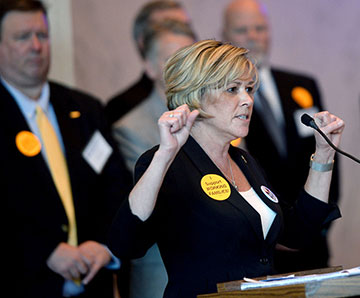 The suits talk strike. AFT/WV
leader Christine Campbell at January 24 rally says
leadership is just following the membership.
The suits talk strike. AFT/WV
leader Christine Campbell at January 24 rally says
leadership is just following the membership. (Chris Dorst/Charleston Gazette-Mail)
Jan. 24 – At rally of West Virginia public employees in Charleston, AFT/WV president Christine Campbell raises possibility of strike. “Campbell said talk of striking if the Legislature fails to act this session to improve teacher pay has come from the local level, not from AFT leadership” (Charleston Gazette-Mail).
Jan. 25 – Meeting of school personnel and state employees in Logan County called by WVEA together with AF/WV discusses possibility walkout. Main demands are funding of Public Employees Insurance Agency (PEIA), salary for all state employees and the attacks on seniority (The Logan Banner).
Jan. 26 – Logan County school employees vote “overwhelmingly” for one-day walkout (The Logan Banner).
Jan. 29 – President of Mingo County WVEA announces teachers there and in Wyoming County voted for walkout. Seven counties holding meetings to decide on walkout. AFT/WV sending staff to meeting “to figure out what’s going on.” WVSSPA leader (non-teaching personnel) not for a strike now, “but that’s me. We work with our membership” (Charleston Gazette-Mail).
Jan. 30 – Parents and students demonstrate in support of teachers outside Mingo County schools (The Logan Banner).
Feb. 2 – “Hundreds of school faculty members from Logan, Mingo, Wyoming, McDowell, Raleigh and Boone counties were in attendance during a one-day walkout and rally at the state Capitol.” “Walk-in” demonstrations outside Boone, Kanawha, McDowell, Monongalia and Raleigh County schools (Williamson Daily News). Gov. Justice cancels press conference.
Feb. 3 – Teacher meeting with state lawmakers in Charleston put on by Kanawha County Education Association.
Feb. 11 – Union leaders from all 55 counties met in Flatwoods to review votes from school employees on authorizing the statewide work stoppage. In every county a majority were for statewide action. WVEA and AFT/WV leaders to make decision on date.
Feb. 12 – House of Delegates proposes that teachers get 2% this year, and 1% each year for the next three years.
Feb. 16 – Second wave of county-wide walkouts. This time not just southern counties. Brooke, Cabell, Clay, Lincoln, Mason, Wetzel and Wayne county schools shut down. Hundreds of teachers flood state capitol building. Chants of “We will strike! We will strike!” (Charleston Gazette-Mail)
Feb. 17 – Unions announces statewide walkout at a rally at the Capitol. “The entire state of West Virginia will be shut down,” said WVEA president Dale Lee, “all 55.” (WV MetroNews)
Feb. 21 – Gov. Justice signs 2-1-1 bill.
Feb. 22 – Statewide walkout by teachers, custodial and cafeteria staff and bus drivers.
Feb. 23 – Under pressure from ranks, union leaders announce strike will continue Monday, Feb. 26.
Feb. 26 – Union leaders announce strike will continue Tuesday. At rally, UMWA president Cecil Roberts invokes the Battle of Blair Mountain, Mother Jones, Martin Luther King Jr. and “called on “every union member in the state of West Virginia” to stand with teachers. All 55 county school systems closed. Over 5,000 people in state capitol.
Feb. 27 – Gov. Justice meets with union leaders Tuesday evening, agree to 5% pay raise. WVEA president Lee says, “We believe the best course of action at this time is to return to school. However we realize that not everyone will” (WV MetroNews). Uproar on steps of capitol when “deal” announced, teachers shouting “Back to the table.” Unions expect teachers to go back to work Thursday, March 1.
Feb. 28 – Supposed to be a “cooling off” day, instead opposition to deal heats up. House votes 5% raise for teachers and 3% for other state. House committee amended the bill to include 5% raise for state police. Senate does not vote on bill. At 10:30 p.m. all counties announce no school tomorrow.
March 1 – Strike continues.
March 2 – Strike continues, thousands in state capitol. Anti-union Charleston Daily Mail editorial tells strikers: “listen to your union leaders and return to work.” Senate president Mitch Carmichael calls for 4% raise.
March 3 – Senate “accidentally” passes bill for 5% raise rather than intended 4%.
March 4 –Unions say they are considering legal action after the debacle on Saturday, call on all education workers to capitol on Monday, March 5.
March 5 – Over 7,000 jam the capitol. Strikers and supporters wait in long lines for up to 3 hours to get in.
March 6 – 5% raise for all public employees passes House and Senate, governor signs law, strikers cheer, strike ends.
March 7 – First day back to work for teachers. ■
- 1. In the final state budget, the 5% pay raise was extended to all state employees.
- 2. The official figures themselves are suspect. There are reports of teachers with, for example, 19 years seniority who only make $39,000 a year; or with a masters degree and 15 years seniority making $41,000.
- 3. The CSEW is a tendency in New York City education unions politically supported by the Internationalist Group; the RIY is the youth section of the IG.
- 4. In the last West Virginia teachers strike, in 1990, Jefferson and Greenbrier counties tried to force teachers back to work, threatening to fire them.
- 5. A longtime Republican, Justice ran for governor as a Democrat, then switched back to the Republicans in 2016 to back Trump.
- 6. See “Working Families Party: Putting Lipstick on a Pig,” The Internationalist special issue, November-December 2012.
- 7. See “SEP/WSWS: Scab ‘Socialists’,” The Internationalist, December 2007
- 8. Leon Trotsky, “Trade Unions in the Epoch of Imperialist Decay” (1940).
- 9. The agency shop is closely tied to the dues check-off, where the employer deducts union dues from employee paychecks and then passes this money onto the union. This arrangement is the ultimate in class collaboration, guaranteeing the union leaders a steady income while giving the boss control over it. Class-conscious unionists do not support the dues check-off, calling instead on the unions to collect their own dues, which also makes for stronger unions. At the same time we call to smash this attempt at union-busting with sharp class struggle. See “UFT Tops Won’t Fight Union-Busting ‘Right-to-Work,’ Endorse Democrat de Blasio,” Class Struggle Education Workers, 12 February 2017; and Class Struggle Workers – Portland, “It Will Take Hard Class Struggle to Defeat ‘Right to Work’,” reprinted in The Internationalist No. 48, May-June 2017.
- 10. See “Wisconsin Unions Vote to Prepare a General Strike – The Time to Act Is Now” (22 February 2011) and “Wisconsin: For a General Strike Now!” (13 March 2011), and other articles in The Internationalist No. 33, Summer 2011.
- 11. See “Capitalism Killed West Virginia Miners,” The Internationalist No. 23, March-April 2006 on the Sago mine disaster.
- 12. See “To Hell with the Bosses’ Parties – For a Class-Struggle Workers Party!” in The Internationalist No. 45, September-October 2016.
- 13. Class Struggle Education Workers Formed (2008).